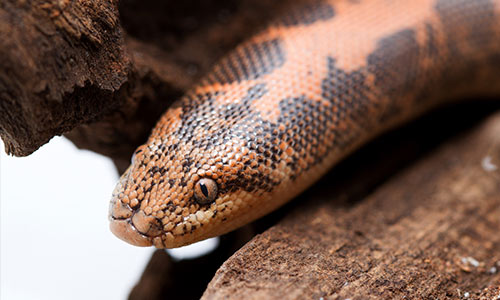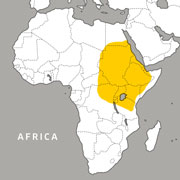Kenyan Sand Boa
Gongylophis colubrinus
You Can Find This Animal in the Tropical Forest
Eye Sssssssee You!
The sand boa's eyes and nostrils are on the top of its head so it can hide under the surface of the sand to wait for prey.


Geographic Range:

Class: Reptilia
Order: Squamata
Family: Boidae
Genus: Gongylophis
Species: colubrinus
Kenyan sand boas are heavy bodied with small eyes and a short tail. Their back is yellow or orange with dark brown splotches. These snakes are constrictors that mainly feed on small mammals and lizards. Sand boas will lay in shallow burrows, with only their heads exposed, and wait to ambush their prey. Once wrapped around their prey, the sand boa may drag it under the sand to eat.
Kenyan sand boas are heavy bodied with small eyes and a short tail. Their back is yellow or orange with dark brown splotches. The belly is either white or cream. Those in the pet trade may differ in coloration and pattern.
Sand boas spend most of their time burrowed in the sand or under rocks to avoid the heat. They are docile and when threatened will bury themselves in the sand.
Weight: up to 2 pounds
Length: Females, 26-32 inches; Males, 15 inches
Mating occurs primarily in the spring and summer. After a gestation period of four months, Kenyan sand boas give birth to four to 20 live young. Kenyan sand boas reach sexual maturity at 2-3 years of age.
Kenyan sand boas may live into their late teens.
The primary habits of the Kenyan sand boa are semi-desert and scrub savannahs and rock outcroppings, all habitats where there is loose sand to burrow in. They range through Egypt, Sudan, Ethiopia, Kenya, Libya, Chad, Niger, Yemen, Tanzania, and Somalia.
Kenyan sand boas are constrictors that mainly feed on small mammals and lizards. Sand boas will lay in shallow burrows, with only their heads exposed, and wait to ambush their prey. Once wrapped around their prey, the sand boa may drag it under the sand to eat. Sand boas will also go into the burrows of other animals to prey on the young.
Kenyan sand boas are listed as being of least concern. Their main threats are loss of habitat and the pet trade.
The sand boa's eyes and nostrils are on the top of its head so it can hide under the surface of the sand to wait for prey.
At Franklin Park Zoo:
At Stone Zoo:


